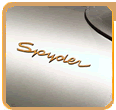|
 Porsche 550 Spyder Porsche 550 Spyder |
|
A rare picture of a 550 Spyder production line.
The 550 Spyders
The first 500's appeared in 1953. These were the first true
competition-bred Porsches; lightweight, two seat, aluminum bodied,
tubular framed, open-topped cars. The initial pair of 550's
was unique unto themselves, racing only with Volkwagen-derived
pushrod boxer four cylinder engines, fitted with detachable
roofs. These dominated their class at Le Mans finishing one-two
in the 1500cc division. Later, one of them won its category
in the famed Pan Americana Mexican road race.
Subsequent 550's, all fitted with the four-cam Carrera flat
four cylinder, carried on what the initial 550's had started.
The became the dominant cars world wide in the small displacement
sports racing categories in the factory's hands, but also in
the hands of Porsche's customers who purchased every one of
the quick little cars they could find.
In 1956, Porsche introduced a slightly modified Spyder, the
550A. This shocked the racing world when it won the brutal Targa
Florio road race outright in its debut appearance, humbling
such well-known and much more powerful rivals as Ferrari, Maserati
and Jaguar. During the next five years the 550A continued winning,
for the factory, and the factory's customers in almost every
venue where it competed. Indeed, it was a car that got more
attention for its occasional loses than it did for its nearly
non-stop string of victories.
Initially the early 550 Spyders were powered by engines developed
from Volkswagen, of pushrod Boxer four cylinder design. In later
months the 550 Spyder assured Porsches racing heritage by winning
the Pan Americana Mexican road race.
When put into production the 550 Spyder was fitted a Fuhrmann
engine, a 1500cc four-camshaft Carrera, flat four cylinder block
producing 110 bhp.
The car was of lightweight tubular steel construction, a true
two seated sports car
rear view
James Jean in the mid-fifties, his particular car was named
'Little Bastard'. (pictures below)
Although the Spyder is well remembered today for its outstanding
racing attributes, it is also lesser known for its ownership
by James Jean in the mid-fifties, his particular car was named
'Little Bastard'. Horrifically it was this car that were to
take his life. It was reported that Dean was being driven by
his German mechanic, Rolf Wutherich (pictured above) at the
time who was rumoured to road racing another motorist along
Route 446, a Californian highway at the time. A vehicle pulled
out, in to the path of James Deans 550 Spyder and a fatal collision
occurred. The mechanic lived and the motorist was not prosecuted
as the mechanic driving the Spyder was of German origin and
the values of World War Two stood to ensure that the prosecution
would be overruled.
Just 90 Porsche 550 Spyders were lovingly hand-built by Old
World craftsmen between 1954 and 1956; no two of them look exactly
alike. Rarely will such a car be put on the market; if it happens,
Spyder ownership will usually be restricted to the inner circle
of cognoscenti of the marque. Prices far exceed half a Million
Dollars.
Spyder aluminum body construction was commissioned to coachbuilder
WENDLER in Reutlingen, the heart of the Fatherland. WENDLER’s
trademark was a pair of beautiful, teardrop-shaped body badges,
mounted to the front fenders.
Redefining the idea of a minimalist car, the 550A features
an open cockpit. The engine is mounted amidships, just behind
the driver. Not unlike a Lotus 11, the Spyder is living proof
that size does matter. These featherweight, one-and-a-half-liter
cars were true dragon slayers; innumerable racing successes
included many placements well ahead of far larger machines,
such as the 4.5-liter Maseratis and Ferraris of the period.
So, what’s lurking behind these aluminum bars, you might wonder?
Quite a surprise! Instead of the vulnerable 1950s four-cam
motor, a prime example of Porsche's own Type 616/36 pushrod
engine has found its way into this Spyder. The power plant is
of 1966 vintage; its main assets are great compression, superior
oil pressure, and the absence of any oil leaks. Topped by twin
dual throat Dell’Orto carburetors with velocity stacks and mesh
screens, and recently tuned by our Senior master technician
Dieter, the 1600 dual port Porsche engine is in fine fettle
and healthy as the proverbial ox.
Weighing only 1136 lbs. (!), the Spyder is built around a tubular
space frame, just like its contemporaries, the Mercedes 300SLR
and the "Birdcage" Maserati. Dash is all business,
with its famous trio of green-on-black gauges--large tachometer
in the middle--and wood-rimmed steering wheel.
So what's it like, driving a street-legal race car, an automobile
icon, a car so extreme that it stops other drivers in their
tracks?
With an estimated 110 horsepower from 1.6 liters (69 horsepower
per liter displacement), this engine is destined to last. But
make no mistake: the power-to-weight ratio is about equal to
the one found on a pure, 260 hp Porsche 930 Turbo. Acceleration
is fierce, and the Boxer motor, sitting right behind your back,
won't let you doubt its intentions for a second. Keep the revs
up, and it screams all the way to redline, like there's no tomorrow.
Occasional flame spitting from the handcrafted, large diameter
exhaust pipe is part of the fun you won't want to miss, trust
me. |




